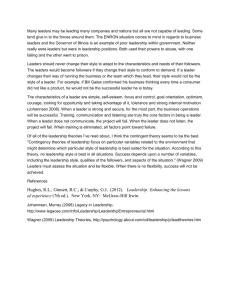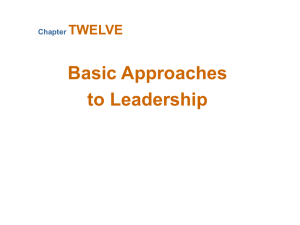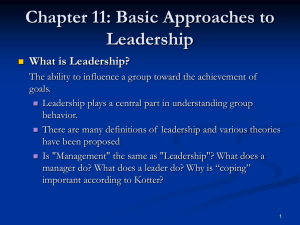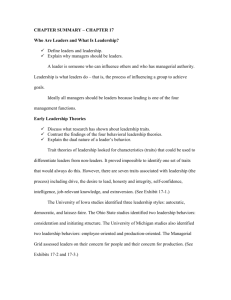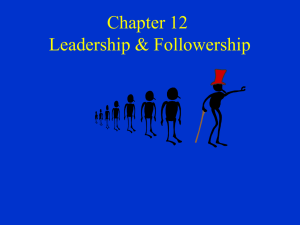Chapter 3 Personality, Perception, and Attribution Authors???
advertisement
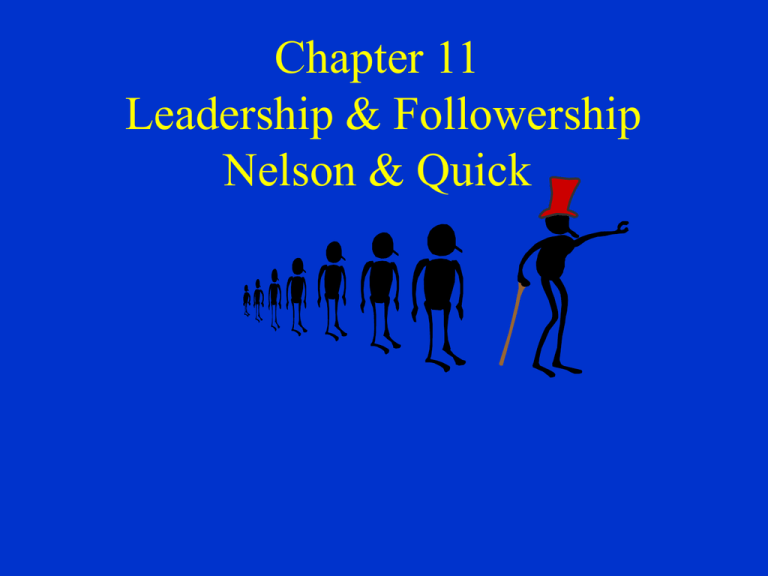
Chapter 11 Leadership & Followership Nelson & Quick Leadership & Followership Leadership - the process of guiding & directing the behavior of people in the work environment Formal leadership - the officially sanctioned leadership based on the authority of a formal position Informal leadership - the unofficial leadership accorded to a person by other members of the organization Followership - the process of being guided & directed by a leader in the work environment Leadership vs Management Leadership & management are distinct, yet complementary systems of action Effective management controls complexity Effective leadership produces useful change Effective leadership + good management = healthy organizations Management Process • Reduces uncertainty • Provides stability • Components – Planning & budgeting – Organizing and staffing – Controlling & problem solving Leadership Process • Creates uncertainty • Creates change • Components – Setting organizational direction – Align people with the direction via communication – Motivate people to action • Empowerment • Need gratification Leadership Theory Typology Degree of generalizability Leader attribute Universal Contingent Traits Type I Type III Behaviors Type II Type IV Reprinted by permission, A. G. Jago, “Leadership Perspectives in Theory and Research,” Management Science 22 (1982): 316. Copyright© 1982, The Institute of Management Sciences (currently INFORMS), 901 Elkridge Landing Road, Suite 400, Linthicum, Maryland 21090-2909 USA. Type I Universal Trait Theories of Leadership • Universal Trait theories - attempt to identify the traits &/or inherent attributes of leaders & the impact of these traits &/or styles on followers • Early Type I theories – focused on a leader’s physical attributes, personality, & ability • Current Type I theories – focus attention on the distinctions between leaders & managers – focus on charismatic leadership Transactional & Transformational Leadership As a transactional leader, I use formal rewards & punishments. As a transformational leader, I inspire and excite followers to high levels of performance. Leaders as Distinct Personalities Leader - an advocate for change & new approaches to problems Manager - an advocate for stability & the status quo Do not rock Leaders & Managers Personality Dimension Attitude toward goals Work conceptions Manager Leader Impersonal, passive, Personal, active functional Enabling processLooks for fresh combines people, ideas & approaches to old things problems Relationships Prefers to work with Comfortable in solitary others but avoids work, encourages closeness & conflict closeness, not conflict adverse Sense of self Born once, Twice born, struggles for straightforward life sense of life order, adjustment questions life Emergence of Women Leaders Charismatic Leadership • Charismatic leadership - the use, by a leader, of personal abilities & talents in order to have profound & extraordinary effects on followers • Charisma - gift in Greek • Charismatic leaders use referent power • Potential for high achievement & performance • Potential for destructive & harmful courses of action Type II Universal Behavior Theories of Leadership • Universal behavior theories - discriminate the leaders’ actions from the followers’ perspective • Early Type II theories – classified leaders by style: autocratic, democratic, or laissez-faire • Current Type II theories – examine common behavior dimensions of all leaders – help organizations train & develop leaders rather than select them Leadership Style & Emotional Climate Autocratic style the leader uses strong, directive, controlling actions to enforce the rules, regulations, activities, & relationships in the work environment; followers have little discretionary influence Democratic style the leader takes collaborative, reciprocal, interactive actions with followers; followers have high degree of discretionary influence Laissez-fair style the leader fails to accept the responsibilities of the position; creates chaos in the work environment Leadership Behaviors Initiating structure leader behavior aimed at defining & organizing work relationships & roles, as well as establishing clear patterns of organization, communications, & ways of getting things done Consideration - leader behavior aimed at nurturing friendly, warm working relationships, as well as encouraging mutual trust & interpersonal respect within the work unit Leadership Styles in Japan P-oriented behavior • encourages a fast work pace • emphasizes good quality & high accuracy • works toward highquantity production • demonstrates concern for rules & regulations M-oriented behavior • sensitive to employees’ feelings • emphasizes comfort in the work environment • works to reduce stress levels • demonstrates appreciation for follower contributions Source: Reprinted from “The Performance-Maintenance (PM) Theory of Leadership: Review of a Japanese Research Program by J. Misumi and M. F. Peterson published in Administrative Science Quarterly 30 (1985): 207 by permission of Administrative Science Quarterly © 1985. Managerial Grid High 1.9 Country club 8 management 9.9 Team management 9 Concern for People 7 6 5.5 Organization man management 5 4 Authorityobedience management 9.1 3 Impoverished management 1 1.1 2 “The Leadership Grid” from Leadership Dilemmas - Grid Solutions, by Robert R. Blake and Anne Adams McCanse. Huston: Gulf Publishing Company, p. 29. Copyright© 1991 by Scientific Methods, Inc. Reproduced by permission of the owners. Low 1 2 3 4 5 6 7 Concern for production 8 9 High Type III Contingency Theories of Leadership • Contingency theories concerned with identifying the situationally specific conditions in which leaders with particular traits are effective • Central concern - how the leader leader’s traits interact with situational factors in determining team effectiveness in task performance situation Fiedler’s Contingency Theory Fiedler’s Contingency Theory - classifies the favorableness of the leader’s situation – leader’s position power - authority associated with the leader’s formal position in the organization – structure of the team’s task - degree of clarity, or ambiguity, in the team’s work activity – quality of the leader-follower (group members) interpersonal relationships – least preferred coworker (LPC) - the person a leader has least preferred to work with over his or her career Leadership Effectiveness in the Contingency Theory High LPC 1.00 relations oriented .80 Correlation between leader LPC & group performance .60 .40 .20 0 -.20 -.40 -.60 -.80 Low LPC task oriented Favorable for leader Leader-member relations Task structure Leader position power I II III IV V I G II G III G IV G S S Uns Uns Strong Weak Strong Weak VI VII Unfavorable for leader VIII V VI VII MPoor MPoor MPoor VIII Poor S Uns Uns Uns Strong Weak Strong Weak F. E . Fiedler, A Theory of Leadership Effectiveness (New York: McGraw-Hill, 1964.) Reprinted by permission. Path-Goal Theory of Leadership Leader behavior styles • Directive • Supportive • Participative • Achievement oriented Follower Characteristics • Ability level • Authoritarianism • Locus of control Follower path perceptions Effort-PerformanceReward linkages Workplace characteristics • Task structure • Work group • Authority system Follower goals • Satisfaction • Rewards • Benefits Hersey-Blanchard Situational Leadership Model Leader’s concern with task Low High P. Hersey and K. H. Blanchard, Management of Organizational Behavior: Utilizing Human Resources, 3d ed., 1977, p. 170. Englewood Cliffs: Prentice Hall. High Leader’s concern with relationship Low Mature Employees Willing/Able Unwilling/able Willing/unable Unwilling/unable 4 3 2 1 Immature Employees Guidelines for Leadership • Unique attributes, predispositions & talents of each leader should be appreciated • Organizations should select leaders who challenge but not destroy the organizational culture • Leader behaviors should demonstrate a concern for people; it enhances follower well-being • Different leadership situations call for different leadership talents & behaviors • Good leaders are likely to be good followers Five Types of Followers Independent, critical thinking Alienated followers Effective followers Survivors Passive Sheep Yes people Source: R. E. Kelley, “In Praise of Followers,” Harvard Business Review 66 (1988): 145. Independent, uncritical thinking Active Dynamic Follower • Responsible steward of his or her job • Effective in managing the relationship with the boss • Practices selfmanagement

